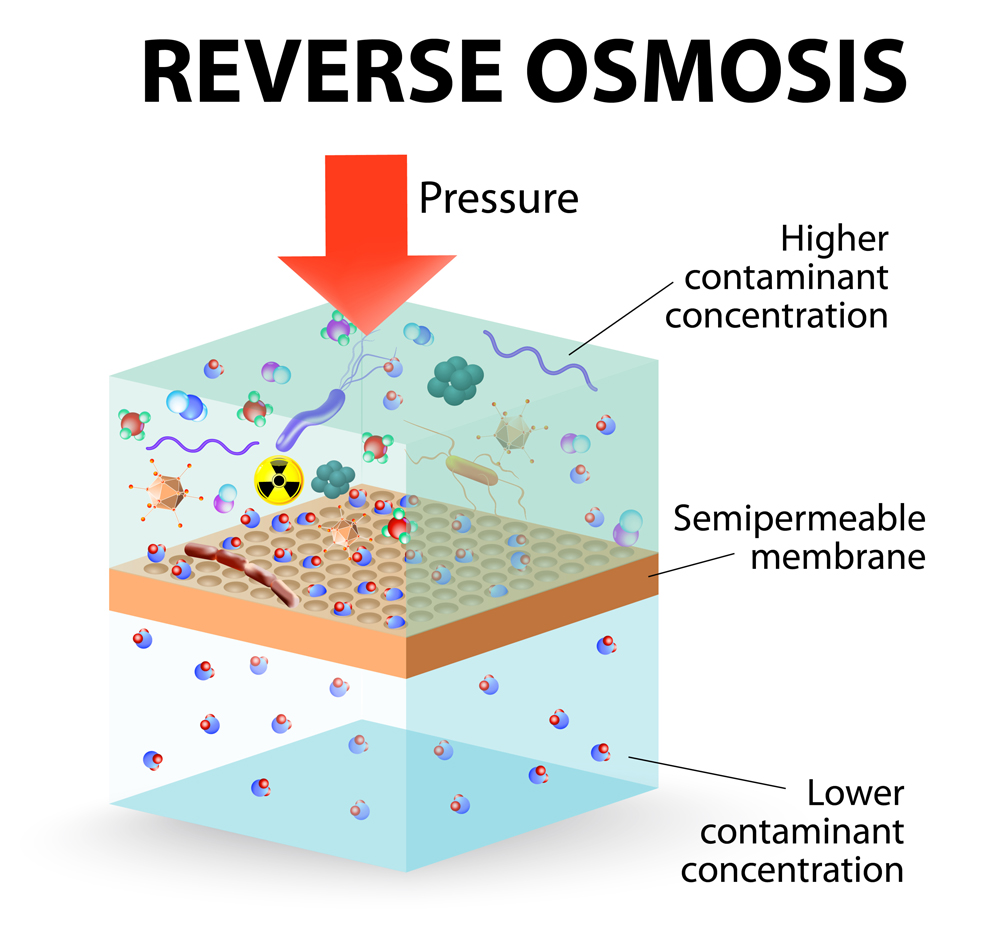Table of Contents (click to expand)
RO is short for reverse osmosis. Water with high salt content and impurities is passed through a filter at high pressure. This causes the salt and the impurities to get filtered out while the resultant water is purified.
The water on our planet is in a closed cycle, which means that there is a fixed amount, and more water cannot be created. The existing amount of water on the planet is constantly being recycled by nature. However, what serves human needs, out of the vast amount of planetary water, is the tiny fraction of salt-free and unpolluted freshwater.
Our urban authorities and the municipal corporations of cities supply us with clean water for our daily activities, but often, even all they do isn’t enough. For example, take a country like India, where 70% of the surface water is contaminated.
Another issue is that if you live in an old building with old plumbing, your pipes could have rust and bacteria inside them, which will pollute the water.
With that in mind, depending on the country or region you reside, it may be common for households to install an RO water filter to ensure the cleanest water possible.
What Is RO And Why Is It Used?
RO stands for Reverse Osmosis—the flow of solvent (water, in our case) molecules through a selectively permeable membrane into a region of lower solute (something dissolved in the solvent, like salts) concentration. If you’d like to know more about reverse osmosis, check out this comprehensive article.

The main purpose of a reverse osmosis filter is to remove the micro-organisms and total dissolved solids (TDS) present in water. Total dissolved solids include minerals, as well as organic molecules present in the water. Of all these small molecules, some may be beneficial trace minerals, but others can be toxic pollutants.
Reverse osmosis isn’t just applied in simple household water filters, but also on a much larger scale in wastewater treatment plants. Desalination plants—plants that remove salt from water—also use this method to make seawater drinkable. This technology makes it possible for ships at sea to filter seawater in order to obtain fresh drinking water.
Also Read: Why Can’t We Boil Salt Water To Obtain Fresh Water?
Mechanism Of An RO Filter
The setup of a filter like this is very simple. Water from the building pipes (or any other source) enters the RO machine and passes through a pre-filter, which is a filter placed before the semi-permeable membrane. The job of this pre-filter is to filter out all large particles, such as sediment, dirt and even rust that may come through the pipes with the water. This filter is relatively cheap and increases the overall lifespan of the RO filter.
After crossing this pre-filter, the water reaches the semipermeable membrane, also known as the reverse osmosis membrane. This is a carefully designed, multi-layered membrane made of polymers such as polyamides, and cellulose.
Polyamides can be artificially created or taken from natural sources, such as wool and silk. Cellulose membranes are the oldest and have been in use since 1955, but polyamide polymers are much more efficient.
A high-pressure pump is used to push the water through the RO membrane. The reverse osmosis membrane has a pore size of less than 1 nm, which is about 90,000 times less than the width of a human hair! These filters remove all the germs present in the water, along with other minute chemical compounds that may be present.
Some RO filters may also include post-treatment filters that improve the flavor of the water.
One side effect of reverse osmosis is that the water usually tastes worse than when it goes in.
This is mainly because the trace minerals and other elements have been removed from the water. Natural freshwater usually contains some amount of mineral and organic water, so humans have evolved to like the taste of that mixture. To counter this side effect, the post-filter may contain mineral balls that selectively replenish good minerals that were lost in the process of RO.
The final product that leaves the filter is clean potable water that is safe to drink. Along with that, the waste products and dirt leave the filter through another pipeline connection that goes to the drain.

Also Read: What Is The Difference Between Distilled Water And Boiled Water?
Advantages Of RO Filters
RO filters are currently the best water filters available and are preferred over other conventional options.
RO systems filter out certain bacteria, fungi and viruses quite well, many of which are responsible for causing common gut-related diseases and other health disorders. These filters are also very efficient at removing toxic chemical components, such as heavy metals and various hard salts. The water that leaves an RO system is 97-98% free of dissolved ions and 99% free of germs and other contaminants. This enhanced filtration capability makes RO filters more preferred, as compared to standard water filters that use either heat, chemicals or ultraviolet light to treat water.
This technology is also quite environmentally friendly. It doesn’t generate much pollution and there is no need for the use of chemicals in the process.
It is very common for RO filters to incorporate additional cleansing strategies, such as more efficient or multiple filters. Alternatively, they may include an additional cleansing system in the form of an ultraviolet (UV) light installed in them. The installed UV lights release UV rays, which kill and destroy any and all microorganisms present in the water by damaging and breaking their DNA.

Disadvantages Of RO Filters
Alas, anything that good must have a catch. The main disadvantage of RO filters is that they are somewhat tedious to maintain.
For example, imagine that one day there is some error in the pump and the water pressure reduces, meaning that the flow of water through the RO membrane will be very slow. This will increase the time taken for the RO filter to purify water. If the filters aren’t regularly cleaned, the RO system may get clogged and bacterial biofilms can form inside the device, further contaminating the water coming in from the pipes.
Another disadvantage is that drinking RO water leads to a depletion of micronutrients. Since RO-filtered water is almost completely free of trace elements and nutrients, it will leach trace elements like magnesium, calcium, copper, and manganese from the body. Such elements are necessary for our body’s many metabolic functions.
While this does pose some health risks, it can be mitigated by a healthy diet, which can supply more than the required doses of vitamins and minerals. However, further research is required to clarify the exact nature and extent of this potential risk.
Conclusion
Advancements in technology are leading to better ways for us to obtain clean water, which is incredibly essential to life. Every single human being should have access to clean drinking water, and the hope is that RO filters will be one way to ensure that… once the price comes down!
RO technology is currently used all over the world to filter wastewater, tap water and seawater. Research in this area is primarily focused on improving the sustainability of RO filters by reducing the energy requirements and improving the durability of the RO membranes!
How well do you understand the article above!

References (click to expand)
- Yang, Zhou, Feng, Rui, Zhang, & Zhang. (2019, July 29). A Review on Reverse Osmosis and Nanofiltration Membranes for Water Purification. Polymers. MDPI AG.
- impact of reverse osmosis on purification of water. Academia.edu
- Venkatesha, R., Rao, A. B., & Kedare, S. B. (2020, April 30). Appropriate household point-of-use water purifier selection template considering a rural case study in western India. Applied Water Science. Springer Science and Business Media LLC.
- A Short Review on Process and Applications of Reverse .... ResearchGate
- (2018) Application of reverse osmosis in purifying drinking water. e3s-conferences.org
- Verma, K. C., & Kushwaha, A. S. (2014, October). Demineralization of drinking water: Is it prudent?. Medical Journal Armed Forces India. Elsevier BV.
